必修5_模块6Saving the antilopes
- 格式:ppt
- 大小:1.78 MB
- 文档页数:25
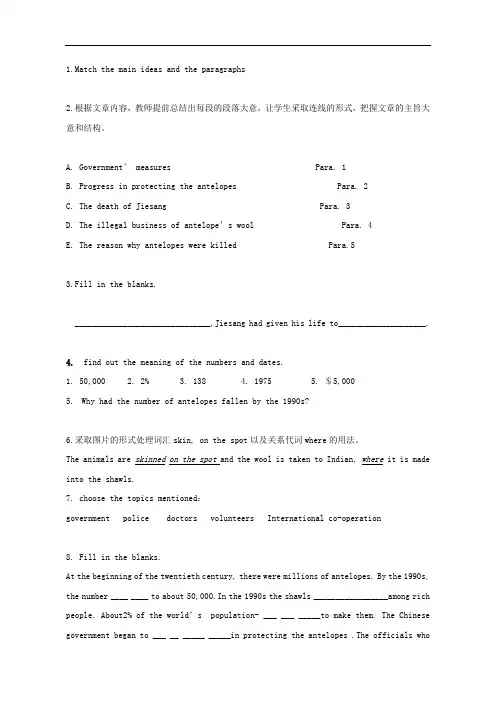
1.Match the main ideas and the paragraphs2.根据文章内容,教师提前总结出每段的段落大意,让学生采取连线的形式,把握文章的主旨大意和结构。
A. Government’ measures Para. 1B. Progress in protecting the antelopes Para. 2C. The death of Jiesang Para. 3D. The illegal business of antelope’s wool Para. 4E. The reason why antelopes were killed Para.53.Fill in the blanks._______________________________,Jiesang had given his life to____________________.4. find out the meaning of the numbers and dates.1. 50,0002. 2%3. 1384. 19755. $5,0005. Why had the number of antelopes fallen by the 1990s?6.采取图片的形式处理词汇skin, on the spot以及关系代词where的用法。
The animals are skinned on the spot and the wool is taken to Indian, where it is made into the shawls.7. choose the topics mentioned:government police doctors volunteers International co-operation8. Fill in the blanks.At the beginning of the twentieth century, there were millions of antelopes. By the 1990s, the number ____ ____ to about 50,000.In the 1990s the shawls _________________among rich people. About2% of the world’s population- ___ ___ _____to make them. The Chinese government began to ___ __ _____ _____in protecting the antelopes .The officials whowork in the reserve are also _____ by volunteers who __________for the difficult conditions of life at 5,000 meters. Since 1997 the antelope population has slowly begun to _______again.9.. Make a dialogue with an antelope about their experience.10. Interview a government official about the measures we have taken.教师给予一定的提示:Interviewer: How many members are there in your family now?Tom (the antelope): Only IInterviewer: Only you? What happened?Interviewer: what measures have you taken in protecting the antelopes?Government official: We have taken an active part in protecting them.interviewer: what about the police?。
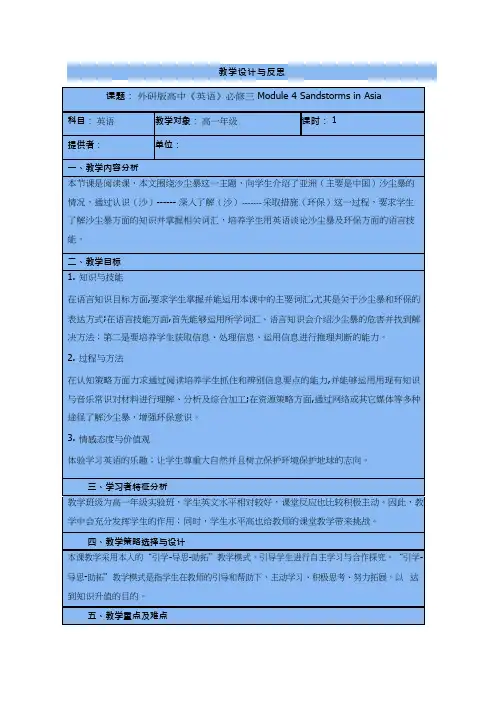
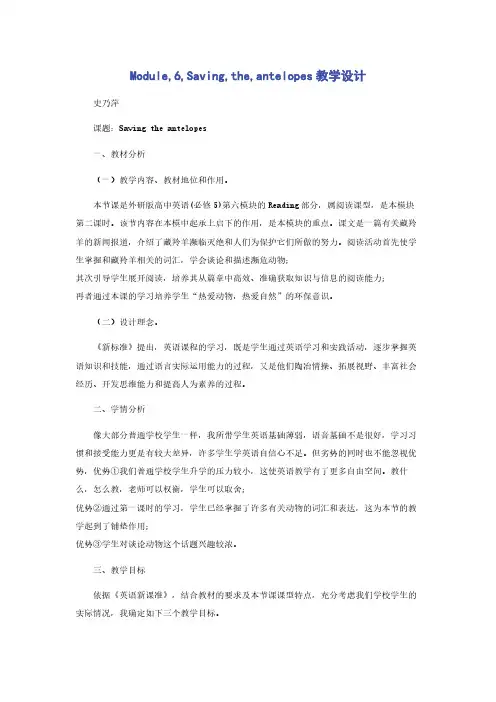
Module,6,Saving,the,antelopes教学设计史乃萍课题:Saving the antelopes一、教材分析(一)教学内容、教材地位和作用。
本节课是外研版高中英语(必修5)第六模块的Reading部分,属阅读课型,是本模块第二课时。
该节内容在本模中起承上启下的作用,是本模块的重点。
课文是一篇有关藏羚羊的新闻报道,介绍了藏羚羊濒临灭绝和人们为保护它们所做的努力。
阅读活动首先使学生掌握和藏羚羊相关的词汇,学会谈论和描述濒危动物;其次引导学生展开阅读,培养其从篇章中高效、准确获取知识与信息的阅读能力;再者通过本课的学习培养学生“热爱动物,热爱自然”的环保意识。
(二)设计理念。
《新标准》提出,英语课程的学习,既是学生通过英语学习和实践活动,逐步掌握英语知识和技能,通过语言实际运用能力的过程,又是他们陶冶情操、拓展视野、丰富社会经历、开发思维能力和提高人为素养的过程。
二、学情分析像大部分普通学校学生一样,我所带学生英语基础薄弱,语音基础不是很好,学习习惯和接受能力更是有较大差异,许多学生学英语自信心不足。
但劣势的同时也不能忽视优势,优势①我们普通学校学生升学的压力较小,这使英语教学有了更多自由空间。
教什么,怎么教,老师可以权衡,学生可以取舍;优势②通过第一课时的学习,学生已经掌握了许多有关动物的词汇和表达,这为本节的教学起到了铺垫作用;优势③学生对谈论动物这个话题兴趣较浓。
三、教学目标依据《英语新课准》,结合教材的要求及本节课课型特点,充分考虑我们学校学生的实际情况,我确定如下三个教学目标。
(一)知识目标。
(1)掌握一些关于藏羚羊的词汇、日常用语及重点句子。
(2)正确理解课文,掌握课文。
(3)对濒危藏羚羊的情况有所了解。
(二)技能目标。
(1)掌握更多阅读技巧,提高自身阅读能力。
(2)能够运用所学词汇,谈论有关濒危藏羚羊的话题。
(三)情感态度目标。
培养学生“热爱动物、热爱自然”的环保意识,鼓励学生积极参加社会上与保护动物有关的公益活动;同时引导学生体验协作劳动的乐趣。

定语从句中关系代词省略与保留一、that在定语从句中作表语时的省略。
关系代词作be 的表语,且先行词是特指时,关系代词通常用that(不用who或which)或省略:He doesn't seem to be the man (that) he was ten years ago. 他看起来已经不是十年前的样子了。
The modern aeroplane is not the machine (that) it was when first invented. 现代飞机已不是最先发明时的那种样子了。
She was not the cheerful woman (that) she was before she married.她已经不是结婚前的那个漂亮女人了。
She is all (that) a teacher should be.她具备一个老师应该具备的所有条件。
但如果先行词是泛指时,关系代词通常用which,且不省略:Even if John were a millionaire which he was not,he would not use a farthing of his wealth to benefit the people. 即使约翰是个百万富翁,他也不会用他的一分钱去做有益于人民的事。
而他并不是百万富翁。
He looked like a lawyer which he was.他像个律师,而他也的确是个律师。
二、that在从句中作补语时。
例如:I'm not the fool(that) you thought me. 我不是你以前所认为的那个傻子了。
He is the nicest teacher (that) the students consider him in their school. 他就是学生认为学校中最好的那个老师。
He is not the man (that) he used to be.She is all (that) a teacher should be.三、作状语时的省略。

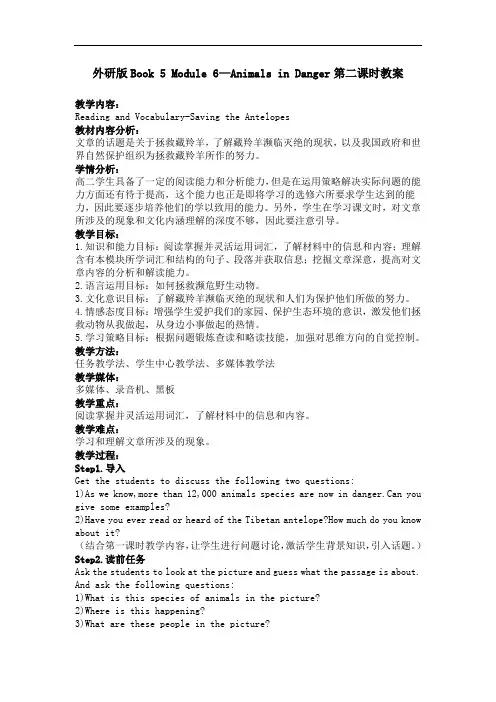
外研版Book 5 Module 6—Animals in Danger第二课时教案教学内容:Reading and Vocabulary-Saving the Antelopes教材内容分析:文章的话题是关于拯救藏羚羊,了解藏羚羊濒临灭绝的现状,以及我国政府和世界自然保护组织为拯救藏羚羊所作的努力。
学情分析:高二学生具备了一定的阅读能力和分析能力,但是在运用策略解决实际问题的能力方面还有待于提高,这个能力也正是即将学习的选修六所要求学生达到的能力,因此要逐步培养他们的学以致用的能力。
另外,学生在学习课文时,对文章所涉及的现象和文化内涵理解的深度不够,因此要注意引导。
教学目标:1.知识和能力目标:阅读掌握并灵活运用词汇,了解材料中的信息和内容;理解含有本模块所学词汇和结构的句子、段落并获取信息;挖掘文章深意,提高对文章内容的分析和解读能力。
2.语言运用目标:如何拯救濒危野生动物。
3.文化意识目标:了解藏羚羊濒临灭绝的现状和人们为保护他们所做的努力。
4.情感态度目标:增强学生爱护我们的家园、保护生态环境的意识,激发他们拯救动物从我做起,从身边小事做起的热情。
5.学习策略目标:根据问题锻炼查读和略读技能,加强对思维方向的自觉控制。
教学方法:任务教学法、学生中心教学法、多媒体教学法教学媒体:多媒体、录音机、黑板教学重点:阅读掌握并灵活运用词汇,了解材料中的信息和内容。
教学难点:学习和理解文章所涉及的现象。
教学过程:Step1.导入Get the students to discuss the following two questions:1)As we know,more than 12,000 animals species are now in danger.Can you give some examples?2)Have you ever read or heard of the Tibetan antelope?How much do you know about it?(结合第一课时教学内容,让学生进行问题讨论,激活学生背景知识,引入话题。
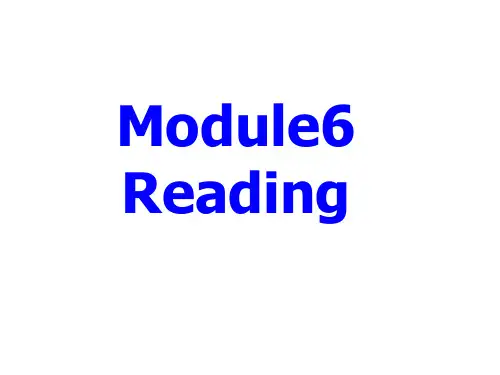
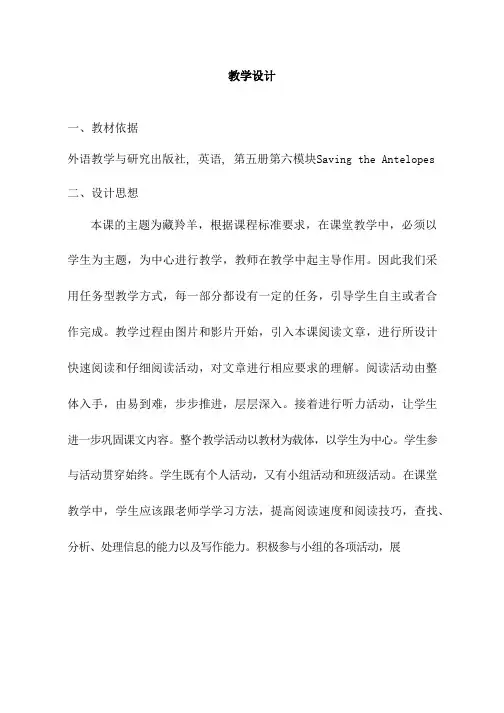
教学设计一、教材依据外语教学与研究出版社, 英语, 第五册第六模块Saving the Antelopes 二、设计思想本课的主题为藏羚羊,根据课程标准要求,在课堂教学中,必须以学生为主题,为中心进行教学,教师在教学中起主导作用。
因此我们采用任务型教学方式,每一部分都设有一定的任务,引导学生自主或者合作完成。
教学过程由图片和影片开始,引入本课阅读文章,进行所设计快速阅读和仔细阅读活动,对文章进行相应要求的理解。
阅读活动由整体入手,由易到难,步步推进,层层深入。
接着进行听力活动,让学生进一步巩固课文内容。
整个教学活动以教材为载体,以学生为中心。
学生参与活动贯穿始终。
学生既有个人活动,又有小组活动和班级活动。
在课堂教学中,学生应该跟老师学学习方法,提高阅读速度和阅读技巧,查找、分析、处理信息的能力以及写作能力。
积极参与小组的各项活动,展现自己和小组的能力,并培养团队协作能力。
在整个教学活动中,学生充分调动其各个感官进行听、说、读、写,积极主动的学习。
三、教学目标1.知识与能力(1)掌握文中的词汇和语言点poacher confiscateantelope come into fashionsurvive at a timeshawls be made intohabitat get tough with话题Describe the favorite city,(2)理解文章大意并能完成相应阅读任务(3)提高运用英语的综合能力2.能力目标在运用语言的过程中培养学生的观察力、分析力、想象力和自学能力,帮助学生加强记忆力,提高思维能力和运用英语的综合能力,激发创造能力。
3.情感目标利用多媒体手段营造积极和谐教学氛围,使学生不自觉的进入情景之中,充分调动学生的思维活动和情感体验,引起学生的共鸣。
本部分旨在培养学生通过阅读手段,获取如何保护动物的常识,提高他们的素质,提高阅读能力,强化文化意识,激发他们热爱动物和保护动物热情。
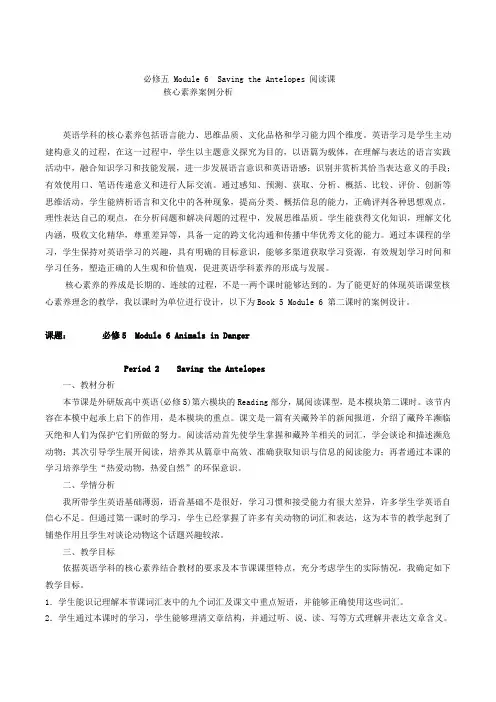
必修五 Module 6 Saving the Antelopes 阅读课核心素养案例分析英语学科的核心素养包括语言能力、思维品质、文化品格和学习能力四个维度。
英语学习是学生主动建构意义的过程,在这一过程中,学生以主题意义探究为目的,以语篇为载体,在理解与表达的语言实践活动中,融合知识学习和技能发展,进一步发展语言意识和英语语感;识别并赏析其恰当表达意义的手段;有效使用口、笔语传递意义和进行人际交流。
通过感知、预测、获取、分析、概括、比较、评价、创新等思维活动,学生能辨析语言和文化中的各种现象,提高分类、概括信息的能力,正确评判各种思想观点,理性表达自己的观点,在分析问题和解决问题的过程中,发展思维品质。
学生能获得文化知识,理解文化内涵,吸收文化精华,尊重差异等,具备一定的跨文化沟通和传播中华优秀文化的能力。
通过本课程的学习,学生保持对英语学习的兴趣,具有明确的目标意识,能够多渠道获取学习资源,有效规划学习时间和学习任务,塑造正确的人生观和价值观,促进英语学科素养的形成与发展。
核心素养的养成是长期的、连续的过程,不是一两个课时能够达到的。
为了能更好的体现英语课堂核心素养理念的教学,我以课时为单位进行设计,以下为Book 5 Module 6 第二课时的案例设计。
课题:必修5 Module 6 Animals in DangerPeriod 2 Saving the Antelopes一、教材分析本节课是外研版高中英语(必修5)第六模块的Reading部分,属阅读课型,是本模块第二课时。
该节内容在本模中起承上启下的作用,是本模块的重点。
课文是一篇有关藏羚羊的新闻报道,介绍了藏羚羊濒临灭绝和人们为保护它们所做的努力。
阅读活动首先使学生掌握和藏羚羊相关的词汇,学会谈论和描述濒危动物;其次引导学生展开阅读,培养其从篇章中高效、准确获取知识与信息的阅读能力;再者通过本课的学习培养学生“热爱动物,热爱自然”的环保意识。
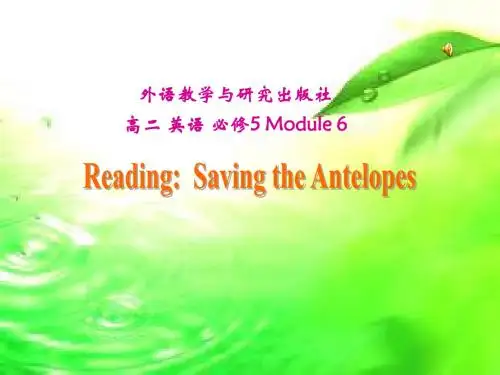
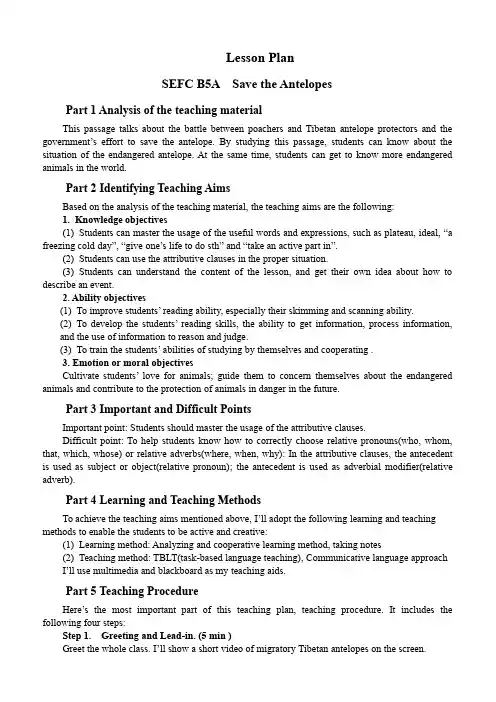
Lesson PlanSEFC B5A Save the AntelopesPart1Analysis of the teaching materialThis passage talks about the battle between poachers and Tibetan antelope protectors and the government’s effort to save the antelope.By studying this passage,students can know about the situation of the endangered antelope.At the same time,students can get to know more endangered animals in the world.Part2Identifying Teaching AimsBased on the analysis of the teaching material,the teaching aims are the following:1.Knowledge objectives(1)Students can master the usage of the useful words and expressions,such as plateau,ideal,“a freezing cold day”,“give one’s life to do sth”and“take an active part in”.(2)Students can use the attributive clauses in the proper situation.(3)Students can understand the content of the lesson,and get their own idea about how to describe an event.2.Ability objectives(1)To improve students’reading ability,especially their skimming and scanning ability.(2)To develop the students’reading skills,the ability to get information,process information,and the use of information to reason and judge.(3)To train the students’abilities of studying by themselves and cooperating.3.Emotion or moral objectivesCultivate students’love for animals;guide them to concern themselves about the endangered animals and contribute to the protection of animals in danger in the future.Part3Important and Difficult PointsImportant point:Students should master the usage of the attributive clauses.Difficult point:To help students know how to correctly choose relative pronouns(who,whom, that,which,whose)or relative adverbs(where,when,why):In the attributive clauses,the antecedent is used as subject or object(relative pronoun);the antecedent is used as adverbial modifier(relative adverb).Part4Learning and Teaching MethodsTo achieve the teaching aims mentioned above,I’ll adopt the following learning and teaching methods to enable the students to be active and creative:(1)Learning method:Analyzing and cooperative learning method,taking notes(2)Teaching method:TBLT(task-based language teaching),Communicative language approachI’ll use multimedia and blackboard as my teaching aids.Part5Teaching ProcedureHere’s the most important part of this teaching plan,teaching procedure.It includes the following four steps:Step1.Greeting and Lead-in.(5min)Greet the whole class.I’ll show a short video of migratory Tibetan antelopes on the screen.Purpose of my design:To catch students’attention about the passage,arouse their interest in the endangered antelopes.Step2.Reading(22min)Task1.(Individual work)Let students skim through the passage and find out what the passage is about.Task2.(Group work)Read the passage again,and let students find out the main idea for each paragraph,and divide the passage into several parts according to its content.Task3.(Class work)Guide students to read the material carefully and take some important notes,such as“the number of+is/was”,the difference of“stop sb from doing/to do sth”,and“skin”can be used as noun and verb.Then,work in pairs and finish the exercise2on page52according to the content of the text.Purpose of my design:Using different reading skills can enable students to understand the given material better.“Task-based”teaching method is used here to develop the students’ability of communication and also their ability of cooperation will be well trained.Step3.Practice(Individual work,15min)(1)Ask students to close books and retell the story.(2)Guide the students to finish the exercise3and4on page53according to the passage.Purpose of my design:Through this exercise,students can exercise their information extraction ability.And I can know whether students master the meaning of some difficult words and phrases(e.g. confiscated;shawl),and the attributive clauses or not.(3)Complete the exercise of the attributive clauses on page54,and point out each relative pronoun and adverb used in what condition.Purpose of my design:This can enable the students to be active and improve the class participation.And if the students can finish the task well,they will master the attributive clauses better.Step4.Summary&Assignment(3min)Summarize what have been learned in the class:(1)The situation about endangered antelopes;(2)How to describe an event;(3)The usage of the attributive clauses.Assignment:1.Choose one of other endangered animals you know and write a description of it.2.Do the exercises in the workbook.Purpose of my design:Homework is so important and necessary for to master the knowledge they learned after class.It will check whether the students achieve the teaching aims or not.Part6.The Design of the BlackboardThe title of this reading passage is on the top of the blackboard.Divide the blackboard into2 parts.The right part is for some key words,while the left part is for the screen.Save the AntelopesHow many kinds of endangered animals do you know?Why are they in danger?Discussion:What should we do to protect these endangered animals?Grammar:the attributive clausese.g.:Sometimes there were gunfights,like the one in which Jiesang Suonandajie was killed.(“in which”refers to?)。
教学设计Reading and Vocabulary-Saving the Antelopes教材内容分析:本课为外研版必修5第6模块濒危动物的第二课时。
本模块以许多动物正在濒临灭绝的现实为主题,复习和学习一些有关野生动物保护的词汇,开始动物灭绝的原因的讨论。
本节阅读课是在此基础上,进一步展开:了解藏羚羊濒危的现状以及人民和政府在拯救藏羚羊中所做出的牺牲和努力。
从而帮助学生增强“拯救野生动物,保护自然”的意识,并从身边的小事做起。
学情分析:高二学生具备了一定的阅读能力和分析能力,但是在运用策略解决实际问题的能力方面还有待于提高,这个能力也正是即将学习的选修六所要求学生达到的能力,因此要逐步培养他们的学以致用的能力。
另外,学生在学习课文时,对文章所涉及的现象和文化内涵理解的深度不够,因此要注意引导。
教学目标:1.知识目标:学习Saving the Antelopes一文,理解文章的大意及其主要信息,并掌握重点单词、短语及句型。
重点单词:endanger,habitat,reserve,struggle,battle,plateau, profit, ban,raid,重点短语:be worth,on the spot,in danger2.能力目标:获取主要信息,根据文章内容对有关陈述进行判断。
3.情感目标:通过所学内容,知道保护野生动物的重要性。
教学方法:1.Task-based method 任务型教学法2.Group cooperation 小组合作探究学习法3.CALL―Computer Assistant Language Learning多媒体辅助教学重点:阅读掌握并灵活运用词汇,了解文章中的信息和内容,使学生了解藏羚羊濒临灭绝的现状,以及我国政府和世界自然保护组织为拯救藏羚羊所作的努力。
教学难点:深入了解导致珍稀动物灭绝的原因,探讨拯救野生动物的措施,口头表达并组织成采访的形式。
教学过程:Step1.导入Greet the whole class as usual. Show the pictures of antelopes ,making sure the students know what the topic is in China.Step2.读前任务(自主学习)重点单词(注意这些单词的正确发音和意思)1.endanger __________2.habitat __________3.struggle _________4.battle __________5.ideal __________6.worth__________7.保护区__________ 8.灭绝的__________ 9.野生动物_______10.盗猎者__________ 11.高原__________ 12.同时__________Step3.读中任务(合作探究)Task1.Read the text quickly and get the main idea of each paragraph and discuss in groups. Also finish the chart according to the numbers and date in the text.快速阅读Saving the Antelopes 一文,完成以下练习:(1)根据每段的段落大意联线。